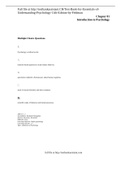HC 9/11
Les 1: criminologische sociologie
Criminaliteit is aangeleerd dmv processen --> Sociaal procestheorieën
Honduras: twee bendes
Bende = duurzame en straatgeorganiseerde ?? waarvan illegale activiteiten deel uitmaken
van hun groepsidentiteit
La Vida Loca (2008)
Anomietheorieën:
Subculturen-theorie Cohen
College boy – Corner boy – Delinquent gang
Differentiële kansen-theorie Cloward & Ohlin
Criminal – Conflict – Retreatist subculture
Focal concerns-theorie Miller
Trouble, toughness, smartness, excitement, fate, autonomy
Sociaal procestheorieën:
Differentiële associatie-theorie Sutherland
Neutraliserings-theorie Sykes & Matza
Gangs in Honduras/Central America
, Gangs in Central America: a history of violence? Gangs as post-conflict phenomenon?
Civil wars and uprisings in El Salvador, Guatemala & Nicaragua
--> Honduras the odd one out?
C-A refugees in the U.S.
LA gangland: Eighteenth Street gang (barrio/pandilla 18), later Mara Salvatrucha (MS-
13)
Mass deportations in the 1990s
U.S. gang practices transferred to C-A
Gangs in Central America: defining a gang
•Eurogang definition: “a street gang
(or troublesome youth group corresponding to a street gang elsewhere) is any durable, street-
oriented youth group whose involvement in illegal activity is part of its group identity” (Weerman et.
al., 2009, p.20).
•“From Pandilla to Mara” (Brenneman, 2012).
•Pandillas: “more localized, home-
grown gangs that are the direct inheritors of the youth gangs that have been a historic feature of
Central American societies. Pandillas were initially present throughout the region in the post-
conflict period but are now only significantly visible in Nicaragua – and to a lesser extent in Costa Rica
(where they are often called ‘chapulines’)” (Rodgers et al. 2009, p. 6).
•Maras: “a
vast network of groups of people associated with the identity franchises of two street gangs that had
their origins in the city of Los Angeles in the USA, but whose development
no longer depends upon the American dynamics: the Mara Salvatrucha Thirteen (MS-13) and the Eig
hteenth Street Gang (also known as Barrio 18).” MS-13 emerged from a division of Barrio 18 (Cruz
2010, p. 382 and 384).
Gangs in Central America: defining a gang
•Context & terminology matter
•Honduras: barrio 18, MS-13, & other smaller gangs
Why focus on women?
Gap in the literature and policy!
Traditional views on youth gangs: where are the girls?
•Thrasher (1963): “gang shag” (p.166)
•Cohen (1955): “delinquency in general is mostly male delinquency” (p.44) à the gang “is a boys’
gang” (p.46)
•Cloward & Ohlin (1964): “[their] book is about delinquent gangs, or subcultures,
as they are typically found among adolescent males in lower-class areas of large urban centers” (p.1)
Problem
The roles of girls in gangs “were described by male gang
members to male researchers and interpreted by male academics” (Campbell, 1990, p.
166).
Les 1: criminologische sociologie
Criminaliteit is aangeleerd dmv processen --> Sociaal procestheorieën
Honduras: twee bendes
Bende = duurzame en straatgeorganiseerde ?? waarvan illegale activiteiten deel uitmaken
van hun groepsidentiteit
La Vida Loca (2008)
Anomietheorieën:
Subculturen-theorie Cohen
College boy – Corner boy – Delinquent gang
Differentiële kansen-theorie Cloward & Ohlin
Criminal – Conflict – Retreatist subculture
Focal concerns-theorie Miller
Trouble, toughness, smartness, excitement, fate, autonomy
Sociaal procestheorieën:
Differentiële associatie-theorie Sutherland
Neutraliserings-theorie Sykes & Matza
Gangs in Honduras/Central America
, Gangs in Central America: a history of violence? Gangs as post-conflict phenomenon?
Civil wars and uprisings in El Salvador, Guatemala & Nicaragua
--> Honduras the odd one out?
C-A refugees in the U.S.
LA gangland: Eighteenth Street gang (barrio/pandilla 18), later Mara Salvatrucha (MS-
13)
Mass deportations in the 1990s
U.S. gang practices transferred to C-A
Gangs in Central America: defining a gang
•Eurogang definition: “a street gang
(or troublesome youth group corresponding to a street gang elsewhere) is any durable, street-
oriented youth group whose involvement in illegal activity is part of its group identity” (Weerman et.
al., 2009, p.20).
•“From Pandilla to Mara” (Brenneman, 2012).
•Pandillas: “more localized, home-
grown gangs that are the direct inheritors of the youth gangs that have been a historic feature of
Central American societies. Pandillas were initially present throughout the region in the post-
conflict period but are now only significantly visible in Nicaragua – and to a lesser extent in Costa Rica
(where they are often called ‘chapulines’)” (Rodgers et al. 2009, p. 6).
•Maras: “a
vast network of groups of people associated with the identity franchises of two street gangs that had
their origins in the city of Los Angeles in the USA, but whose development
no longer depends upon the American dynamics: the Mara Salvatrucha Thirteen (MS-13) and the Eig
hteenth Street Gang (also known as Barrio 18).” MS-13 emerged from a division of Barrio 18 (Cruz
2010, p. 382 and 384).
Gangs in Central America: defining a gang
•Context & terminology matter
•Honduras: barrio 18, MS-13, & other smaller gangs
Why focus on women?
Gap in the literature and policy!
Traditional views on youth gangs: where are the girls?
•Thrasher (1963): “gang shag” (p.166)
•Cohen (1955): “delinquency in general is mostly male delinquency” (p.44) à the gang “is a boys’
gang” (p.46)
•Cloward & Ohlin (1964): “[their] book is about delinquent gangs, or subcultures,
as they are typically found among adolescent males in lower-class areas of large urban centers” (p.1)
Problem
The roles of girls in gangs “were described by male gang
members to male researchers and interpreted by male academics” (Campbell, 1990, p.
166).










